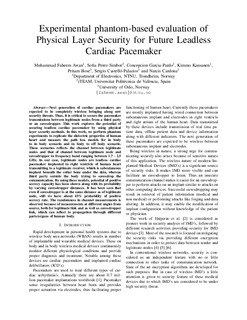| dc.contributor.author | Awan, Muhammad Faheem | |
| dc.contributor.author | Simbor, Sofia Perez | |
| dc.contributor.author | García-Pardo, Concepción | |
| dc.contributor.author | Kansanen, Kimmo | |
| dc.contributor.author | Bose, Pritam | |
| dc.contributor.author | Castello-Palacios, Sergio | |
| dc.contributor.author | Cardona, Narcís | |
| dc.date.accessioned | 2019-07-01T10:50:34Z | |
| dc.date.available | 2019-07-01T10:50:34Z | |
| dc.date.created | 2019-01-08T18:19:58Z | |
| dc.date.issued | 2018 | |
| dc.identifier.isbn | 978-1-5386-6009-6 | |
| dc.identifier.uri | http://hdl.handle.net/11250/2602998 | |
| dc.description.abstract | Next generation of cardiac pacemakers are expected to be completely wireless bringing along new security threats. Thus, it is critical to secure the pacemaker transmissions between legitimate nodes from a third party or an eavesdropper. This work explores the potential of securing leadless cardiac pacemaker by using physical layer security methods. In this work, we perform phantom experiments to replicate the dielectric properties of human heart and measure the path loss models for in body to in body scenario and in body to off body scenario. These scenarios reflects the channel between legitimate nodes and that of channel between legitimate node and eavesdropper in frequency band ranging between 1.7-2.5 GHz. In our case, legitimate nodes are leadless cardiac pacemaker implanted in right ventricle of human heart transmitting to a legitimate receiver, which is subcutaneous implant beneath the collar bone under the skin, whereas third party outside the body trying to eavesdrop the communication. By using these models, potential of positive secrecy capacity has been shown along with its probability by varying eavesdropper distances. It has been seen that even if eavesdropper is at the same distance as of legitimate node, still we have about 45% probability of positive secrecy rate. The randomness in channel measurements is observed because of measurements at different angles from source, both for legitimate link and as well as eavesdropper link, which can reflect to propagation through different parts/organs of human body. | nb_NO |
| dc.language.iso | eng | nb_NO |
| dc.publisher | Institute of Electrical and Electronics Engineers (IEEE) | nb_NO |
| dc.relation.ispartof | 2018 IEEE 29th Annual International Symposium on Personal, Indoor, and Mobile Radio Communications (PIMRC) | |
| dc.title | Experimental phantom-based evaluation of Physical Layer Security for Future Leadless Cardiac Pacemaker | nb_NO |
| dc.type | Chapter | nb_NO |
| dc.description.version | acceptedVersion | nb_NO |
| dc.source.pagenumber | 333-339 | nb_NO |
| dc.identifier.doi | 10.1109/PIMRC.2018.8580808 | |
| dc.identifier.cristin | 1652788 | |
| dc.relation.project | EC/H2020/90074301 | nb_NO |
| dc.relation.project | EC/H2020/675353 | nb_NO |
| dc.description.localcode | © 2018 IEEE. Personal use of this material is permitted. Permission from IEEE must be obtained for all other uses, in any current or future media, including reprinting/republishing this material for advertising or promotional purposes, creating new collective works, for resale or redistribution to servers or lists, or reuse of any copyrighted component of this work in other works. | nb_NO |
| cristin.unitcode | 194,63,35,0 | |
| cristin.unitname | Institutt for elektroniske systemer | |
| cristin.ispublished | true | |
| cristin.fulltext | original | |
| cristin.fulltext | postprint | |
| cristin.qualitycode | 1 | |
